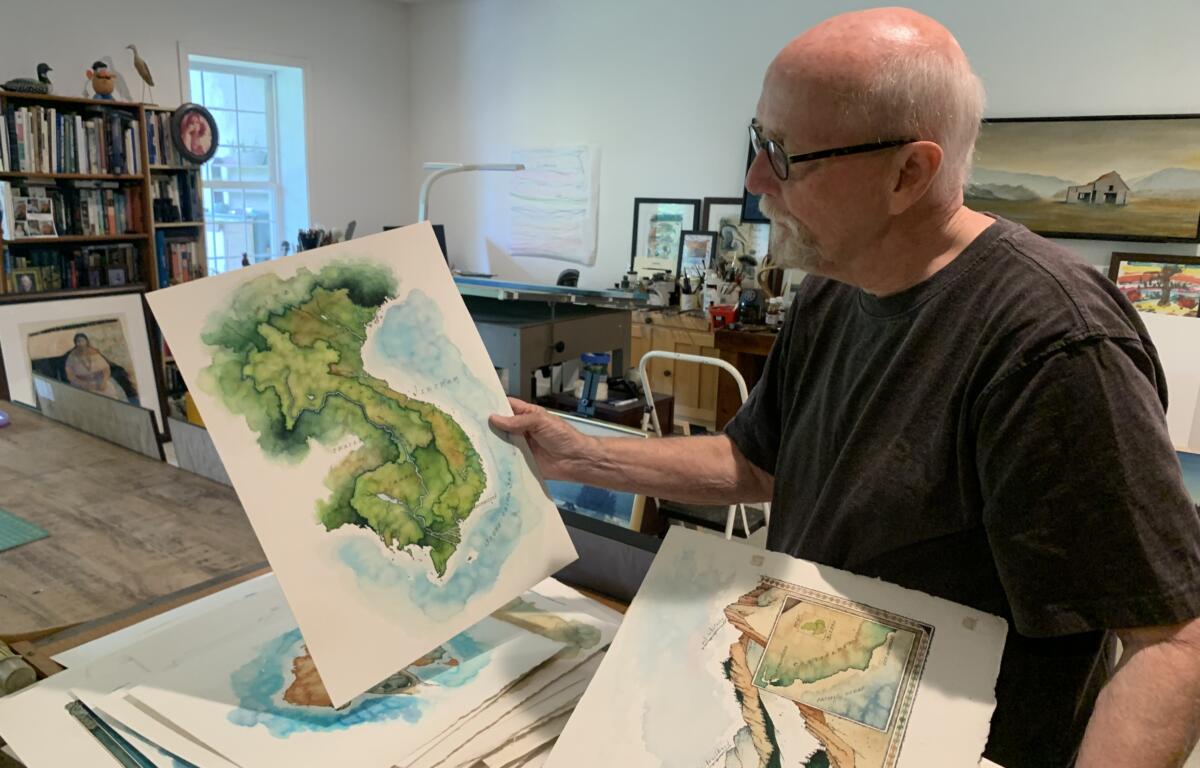MARS HILL, N.C. (828newsNOW) —
It takes a good map to find Michael Francis Reagan’s home.
A tranquil winding gravel road leads up into a mountain neighborhood east of Mars Hill in rural Madison County. Calling it a neighborhood hardly does the forested landscape justice.
Perched on a mountainside 10 miles from the Tennessee border is the gray-painted, wood-slated chalet of Reagan, whom some have called the “Last Mapmaker.”
Above ground, the home of Reagan and his wife, Christine, seems typical for Western North Carolina; couches, a kitchen table, a rug and an espresso machine, all neatly ordered. The Reagan’s secret is below their abode.
Down the flight of creaky wooden stairs is where most would store their winter clothes or Halloween decor, but not the Reagans. Instead, their basement plays a more inspiring role.
Every day, Mike and Christine create together downstairs, sometimes joined by their grandson, focusing on their individual crafts: painting for Mike, weaving for Christine and fingerpainting for the kid.
A double major in Art and English, Reagan graduated in 1972 from the University of Arkansas at Monticello and later with an Masters in Fine Arts in Painting from the University of Fayetteville.
He worked as a plane captain (an enlisted man on the flight deck of a navy ship), Peace Corps artist, art director for KATV in Little Rock and as a freelance illustrator. Later, Reagan transitioned to painting full-time.
Reagan’s big break came after sending some painting samples to a magazine representative outside of New York City. A suggestion came back in the mail: try map illustration. Several decades and more than 2,000 maps later, Reagan is still at it.
Maps, as Reagan makes them, aren’t a short project.
“I do a black and white sketch for the art director first for approval,” he explained. Once commissioned, he traces an atlas onto canvas, outlines and inks the borders, paints and scans it over to the client. “It could take days working six, seven, eight hours a day to complete.”
Reagan grew up on military bases in Japan and Germany, serving in the Navy in Vietnam on the U.S.S. Enterprise and the U.S. Peace Corps in Côte d’Ivoire (then Ivory Coast) where he met his wife. Although he shares the name of a former president, he’s not related and pronounces it “Ree-gan,” not “Ray-gan.”
Reagan’s art blends imagery with map making. Part of his style of painting reflects Japanese methods due to his parents finding “a Japanese artist to come over and give art lessons” when he was 5 years old.
Reagan said he is most proud of his war maps. During the Middle Eastern conflicts of the 2000’s, he made maps to “help educate people on the horrors of those wars,” he said, “and end those wars.”

Reagan often is called the “The Last Mapmaker” because so few people make maps by hand anymore. It begs the question of whether technology killed another profession: cartography?
But Reagan doesn’t consider himself a cartographer.
“Cartography you might think of as what National Geographic does,” said Reagan. “Their maps were made on scientific observation, whereas mine are based on research.” He continued, “I think of myself as a map artist because… I create a feeling of Tahiti,” an accurate map, but focused on “the people, culture and colors of the terrain.”
“They came up with the title ‘The Last Mapmaker’ which sort of troubles me,” he lamented, “but it may be true. I may be the last physical mapmaker… to me, that’s a sad thing.”
“The positive thing is people will go on making paintings because there’s nothing like” handmade art, he said.
His client list includes The National Park Service, National Zoo, Patagonia, Coca-Cola, McDonald’s, American Airlines, National Geographic, Smithsonian, The New Yorker, Los Angeles Times, Washington Post, Wall Street Journal and The New York Times.

Sporting a white goatee these days, Reagan has adjusted his output.
He said that, “Back in the golden era,” the 1980s to early 2000s, he was averaging about 100 maps per year. “Those days are over now,” he said. Partly due to lower demand and a personal change in interest, “Nowadays, I’m doing landscapes,” Reagan said.
“I call these paintings I’m doing ‘memoryscapes,’” Reagan explained. “They aren’t actually places… They’re based on places I’ve seen.” The memory-landscapes often depict beaches, which Reagan fondly remembers pitching Army tents on during his younger years.
“Memoryscapes” are Reagan’s new artistic outlet. “That’s what I want to do from now on,” he explained. “My focus is these paintings.”
Inspired by the beauty of his studio, Reagan is protective over his paintings. “I’m reluctant to turn them loose because I love working with… all these paintings around us.” He joked, “They ask me for them, and I say, ‘I don’t have any.’”
He couldn’t keep his decades of art locked up forever. Some of his pieces are stored in the Library of Congress, some are on display in galleries and a few are being prepared for an exhibition from July 13 to Sept. 15 at Grovewood Gallery, 111 Grovewood Rd., Asheville.
A grand opening is scheduled for 2 p.m. to 5 p.m. on Saturday, July 13.
A collection of Reagan’s maps will be “set up on tables to try to duplicate my studio,” Reagan said.
For the rest of his days, Reagan said, “I’ll continue to just paint.”
CORRECTION: An earlier version of this story mischaracterized Reagan’s work in the U.S. navy. He worked as a plane captain.








